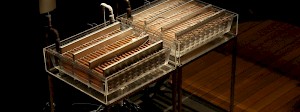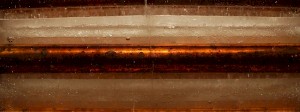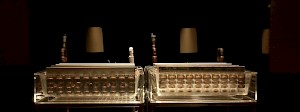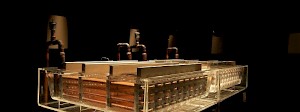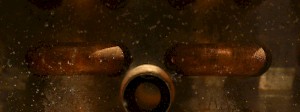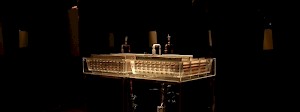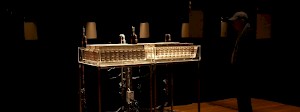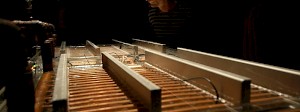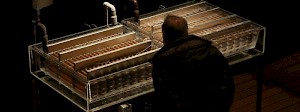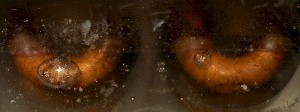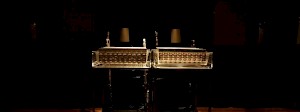Permafrost Aernoudt Jacobs 2009
Permafrost is an environmental sound sculpture about the freezing process of water. An installation has been developed in which we can observe the constantly repeated cycle of freezing and melting. By means of a custom-made sound apparatus the process is made audible. Permafrost deals with the sometimes paradoxical relation between nature and technique.
Permafrost is an installation addressing in the first place the freezing process of water. At the core of Permafrost is a silent machine producing sounds according to her specific condition: the crystallization process becomes the sound source, the matter outgrowing its container becomes visible and tangible (the expansion of ice compared to the water volume is more than 9%). Due to this visual aspect Permafrost is much more a sound sculpture than a mere installation. Different contemporary media are combined in the installation: sound art, kinetic art, sculpture and new technologies. The physic laws of our environment and my fascination for the human perception are an endless source of reflection and creativity.
The formation of ice (as a process) is a fascinating (sonic) experience. It allows the approach of matter transformation - liquid into solid - as a sonic process and to experience how in the end this inaudible process becomes perceivable to the audience. From a scientific point of view I want to research sound conductivity in changing matter - how the same sounds will change along with the consistency change of water. Ice, water and the different stages in between are an ideal platform for this research. Because of their physical qualities water and ice each have a different effect upon sound. This has to do with the speed of sound. The speed at which sound propagates itself through air is about 340m/s (i.e. If sound is produced 340m away it will be heard 1 second later). The speed of sound under water is of 1500m/s; 3 times faster than air. In ice this becomes about 3300m/s. This means that in ice sound reaches its destination 10 times faster than in air. Practically this also means that as matter changes the pitch of the sound will also change. The freezing process will thus produce sounds relating directly to the growth process of crystals.
Permafrost focuses on a central question in my work: how can the complexity, richness and stratification of our direct, daily environment be translated into something that can really be experienced? How can an environmental installation reach a beholder in the most efficient manner? What perceptual conditions can I design to yield specific experiences? What does this tell us about our perception in general? Our experience is always biased by our own structure (our body of experience). Francisco J. Varela writes in his book "The Tree of Knowledge": We do not see the 'space' in the outside world, but we experience it through our own representational space... We cannot just separate the biological and sociological background of our actions from the way in which the world presents itself to us. We don't hear "frequencies", we experience them. Sound is always coloured, not only by form but also by the different layers of meaning we extract from our own experiential background. With Permafrost I research the relation between sound and frequencies by investigating how frequencies, not perceivable by the human ear, still can yield sonic processes which will reach the perceptive scope of the listener. My fascination with reproducing the sound of this process concurs with the paradoxical relationship between technology and nature. This confronted me with ecological issues such as global warming and especially its effects on the melting process of the (former) permafrost, the ice caps that cover the Arctic and the Antarctic. Permafrost sensibilises the visitor about these issues. The technologies to produce Permafrost, is an actor of this paradox.
For the cooling installation the most advanced technological options have been evaluated and realized in cooperation with the University of Diepenbeek, Industrial Sciences and Technology department. They have the necessary international know-how concerning cooling systems. For this installation (machine) a completely new self generating cooling system was designed. A block of ice is produced in a visible way (a 3 hour proces). And it all needed to happen silently. The core concept behind the technology of the cooling unit was to design a system that was highly efficient in its use of energy. It has become a fragile system that is in a equilibrium. Almost a 'perpetuum mobile'. The energies (warmth) that the unit uses to generate the freezing proces are reversely used to apply the melting process.
Concept: Aernoudt Jacobs Executive Production: Q-O2, Overtoon Coproduction: Happy New Ears, Vooruit, STUK, Q-O2, Overtoon Execution Frost Machine: Limburg Catholic University College (KHLim), Department Industrial Science and Technology (iRefrigeration.eu) Sound Consultancy: Amplus/Aevox Thanks: i-propeller, Imal, Pianofabriek Kunstenwerkplaats, Stijn Demeulenaere With the support of the Flemish Authorities, Flemish Community Commission, Transdigital

